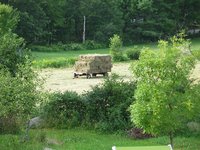
more about haying
We have about seven or eight acres of open pasture. It's been used for hay in the past, but was quickly headed toward becoming a field of weeds and, eventually, a woods again. Our neighbor Dave was kind enough to let me use his Farmall A with a sickle bar mower to cut the grass. Originally my plan was just to cut it before the weeds went to seed, and let it rot in the field as fertilizer for next year's hopefully healthier crop of hay. Hay mowing, it turns out, is nothing like mowing the lawn. It's hard work, especially on an older tractor (this one's from around 1943). At times one is practically wrestling with the machine to keep the sickle bar clear of clumps of hay, and the tractor in something of a straight line. I finished about half of the fields and had to stop mowing to replace the wooden pitman bar, a piece which is made of wood so that it might break if too much pressure is put on the blades, so as to not transmit the problem to the tractor's PTO (no need to explain this) or through to the engine.
 Fortunately, I was approached just then by a local farmer who asked if he could hay the field, and keep a percentage of the crop. I don't have access to the equipment to do a full haying myself, to say nothing of the required skill, so I jumped at the chance to watch someone who knows what they're doing cut the field. A few days later, some diesel pickups could be spotted idling at the edge of the field while the farmer, John T. and his crew made a plan. The cutting which remained was dispatched by John's son Jonathan, with a much more exact execution, making my half of the field look amateurish and uneven, with clumps of uncut grass and weeds still sticking up straight. Jonathan's rows were trimmed evenly, and they were straight.
Fortunately, I was approached just then by a local farmer who asked if he could hay the field, and keep a percentage of the crop. I don't have access to the equipment to do a full haying myself, to say nothing of the required skill, so I jumped at the chance to watch someone who knows what they're doing cut the field. A few days later, some diesel pickups could be spotted idling at the edge of the field while the farmer, John T. and his crew made a plan. The cutting which remained was dispatched by John's son Jonathan, with a much more exact execution, making my half of the field look amateurish and uneven, with clumps of uncut grass and weeds still sticking up straight. Jonathan's rows were trimmed evenly, and they were straight.The cut hay lay in the field for a few days turning gold as it dried. The Jonathan showed up again with his tractor towing an implement called a 'tedder'. The tedder uses long steel rotating fingers to lift and fluff the hay, allowing it to dry more thoroughly. The next day, A second tractor arrived, pulling a hay rake, and yet another tractor with the baler. The pick ups were pulling two hay wagons, one a six wheeler (that's the one in the picture with my last posting below).
 Four or five hours later, the two wagons were full with nearly two hundred seventy bales. Because I have limited use for the hay this year, I told John to keep all but 20 bales, which I'll likely use for mulch. The rest was his. Typically, a field owner would split the hay roughly 50/50 with the team that hays. In the future I expect we'll use that half for our sheep.
Four or five hours later, the two wagons were full with nearly two hundred seventy bales. Because I have limited use for the hay this year, I told John to keep all but 20 bales, which I'll likely use for mulch. The rest was his. Typically, a field owner would split the hay roughly 50/50 with the team that hays. In the future I expect we'll use that half for our sheep.
No comments:
Post a Comment